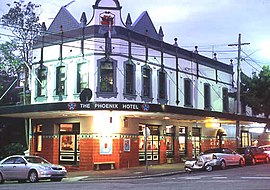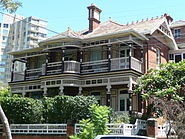| Main | Births etc |
|---|
| Woollahra Sydney, | |||||||||||||
 Phoenix Hotel, Moncur Street | |||||||||||||
| Population: | 7,296 (2006) [1] | ||||||||||||
| Postcode: | 2025 | ||||||||||||
| Location: | 5 km (3 mi) east of Sydney CBD | ||||||||||||
| LGA: | Municipality of Woollahra | ||||||||||||
| State District: | Sydney, Vaucluse | ||||||||||||
| Federal Division: | Wentworth | ||||||||||||
| |||||||||||||
Woollahra is a suburb in the Eastern Suburbs of Sydney, in the state of New South Wales, Australia. Woollahra is located 5 kilometres east of the Sydney central business district, in the local government area of the Municipality of Woollahra. The Municipality of Woollahra takes its name from the suburb but its administrative centre is located in Double Bay. Woollahra is famous for its quiet, tree-lined residential streets and village-style shopping centre.
History[]
Woollahra is an Aboriginal word meaning camp or meeting ground or a sitting down place. It was adopted by Daniel Cooper (1821–1902), the first speaker of the legislative assembly of New South Wales, when he laid the foundations of Woollahra House in 1856. It was built on the site of the old Henrietta Villa (or Point Piper House). Cooper and his descendants were responsible for the establishment and progress of the suburb and its name was taken from the house.[2]
Woollahra was the home of John McGarvie Smith, a metallurgist and biochemist who produced the first preservable anthrax vaccine.
Commercial area[]
Among the cafes and restaurants are a number of antique shops and art galleries. The suburb is also the location of many government consulates, including Serbia, Germany, Russia, Poland and Turkey.
Churches[]

Holy Cross Church, Adelaide Street (designed by Austin Mackay)
One of the more prominent churches, All Saints in Ocean Street, was designed by Edmund Blacket and built from 1874-1881. The church was never entirely finished; it includes a porch that was meant to be a base for a tower and spire, which was designed but never built. It is constructed predominantly of dressed sandstone and is now listed on the Register of the National Estate. It has been described as "a beautifully designed and crafted parish church that has important connections with many famous Australian families." [3]
A stylistic contrast is provided by the Holy Cross Church in Adelaide Street. This brick church was designed by Austin Mackay and built in 1940. It is a rarity insofar as it is an Art Deco church, which is unusual enough, and it also shows the influence of Dutch architecture.[4]
The Congregational Church, cnr Jersey Road and Moncur Street, was built 1875-77 and designed by Benjamin Backhouse. It was burned out much later but eventually restored and converted to residential use. It is listed on the Register of the National Estate.[5]
Housing[]
Woollahra is an extremely affluent suburb, due in part to its proximity to the city and the shopping centre at Bondi Junction, plus a wide range of picturesque homes, mostly in various Victorian styles. Moncur Street and Queen Street are particularly affluent areas, with a mixture of residential and commercial buildings and an extraordinarily high number of heritage-listed buildings.[6] High-rise development has been avoided completely, maintaining the heritage atmosphere of the suburb.
Schools[]
Woollahra Public School opened in 1877. It is a two-storey brick building that was designed by J.Wigram and W.Kemp. The building is listed on the Register of the National Estate.[5] The school includes Opportunity Classes in Years 5 and 6 for gifted students.[7] The school celebrated its Centenary in 1977 and a time capsule was buried in the grounds.
Transport[]
Woollahra is serviced by Sydney Buses, including the 200 and 389 routes, as well as numerous services along Oxford Street in the suburb's south. Routes 333, 378 and 380 all provide direct services to the Sydney CBD from Oxford Street. The 352 on Oxford Street provides commuters with a service to Surry Hills, Newtown and eventually Sydenham in the city's south.
The nearest railway stations are Edgecliff to the north of the suburb and Bondi Junction to the south, both on the Illawarra line. When the Eastern Suburbs railway was constructed in the 1970s, there were plans to include a railway station in Woollahra itself, but this was opposed by local residents and the station was never built.
Culture and events[]
Queen Street Fair[]
In the 1970s, a fair was held in Queen Street. Initially a community fair, it grew and became more commercial until local residents became unhappy with the Queen Street Fair's noise, size, and disruption. Consequently, the fair ceased in the early 1980s.
Gallery[]
References[]
- ^ Australian Bureau of Statistics (25 October 2007). "Woollahra (State Suburb)". 2006 Census QuickStats. http://www.censusdata.abs.gov.au/ABSNavigation/prenav/LocationSearch?collection=Census&period=2006&areacode=SSC12075&producttype=QuickStats&breadcrumb=PL&action=401. Retrieved 3 March 2009.
- ^ Book of Sydney Suburbs, Frances Pollon (Angus and Robertson) 1990, p.273
- ^ The Heritage of Australia, Macmillan Company, 1981, p. 2/138
- ^ Sydney Architecture, Graham Jahn (Watermark Press) 1997, p.141
- ^ a b Heritage of Australia, p.2/138
- ^ Heritage of Australia, pp.2/138-142
- ^ Schools Website:Retrieved 10 February 2010
- ^ A Pictorial Guide to Identifying Australian Architecture, Apperly (Angus and Robertson) 1994, p.92
- ^ Heritage of Australia, Macmillan Company, 1981, p.2/141
External links[]
| ||||||||
| This page uses content from the English language Wikipedia. The original content was at Woollahra, New South Wales. The list of authors can be seen in the page history. As with this Familypedia wiki, the content of Wikipedia is available under the Creative Commons License. |
![(1)Waimea in Waimea Avenue.jpg (604 KB) Waimea, heritage-listed Georgian home (circa 1858), Waimea Avenue[9]](https://upload.wikimedia.org/wikipedia/commons/thumb/9/9a/%281%29Waimea_in_Waimea_Avenue.jpg/185px-%281%29Waimea_in_Waimea_Avenue.jpg)


